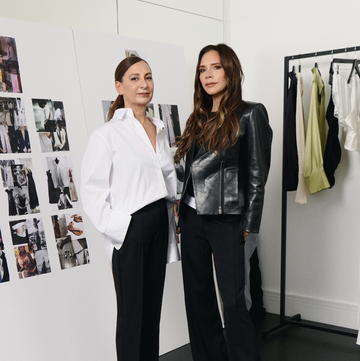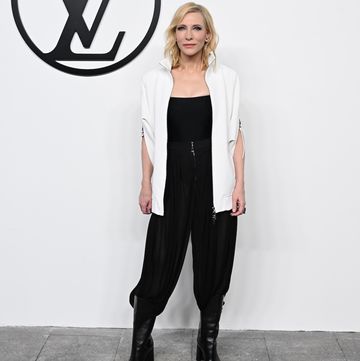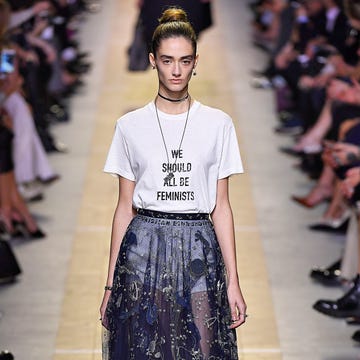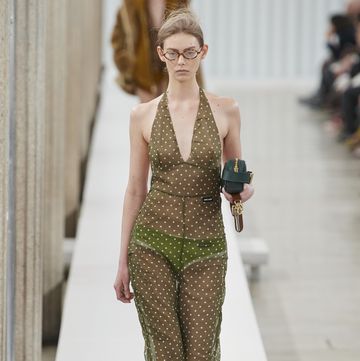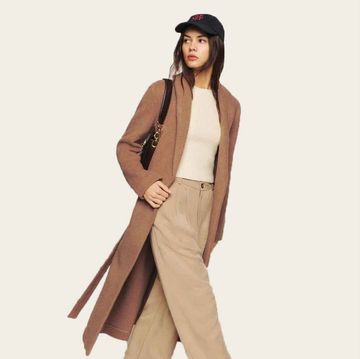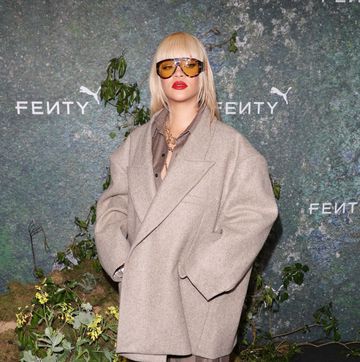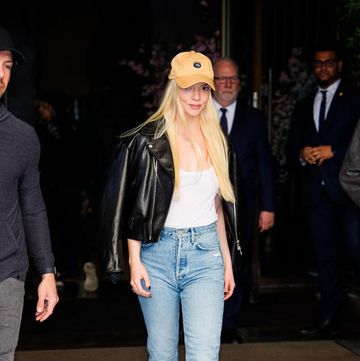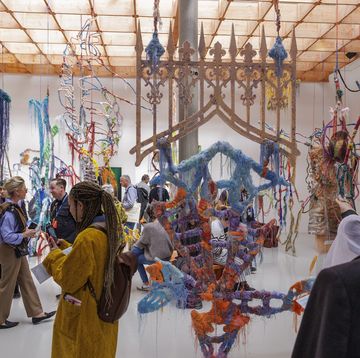GIF: Prada, Moschino, Fendi, Emporio Armani, s/s 2015 - Getty
How predictable is fashion? Yesterday, showed a graceful, thought-provoking collection against a lilac lunar landscape with a thundering apocalyptic soundtrack. Right after, Jeremy Scott turned the catwalk into Barbie World. Prada, as anticipated, tackled the idea of empowering women by considering a wardrobe of serene and dignified clothes based on real life. Jeremy Scott, as expected, made a big, brash joke, this time kitting out human Barbies in bubblegum pink and tumbling synthetic blonde wigs. The audience clapped reverentially for Prada. At Moschino they whooped and laughed.
Because fashion travels at warp speed these days with designers producing a new collection every few months, a certain amount of predictability is a necessity. We need to be able to easily latch on to a powerful brand image – familiarity is a good thing. While we never know what set awaits us as we file into the Prada show or what inspirations have captured Mrs Prada’s imagination, we know that whatever she does will influence the industry. It would be unfair to say that Jeremy Scott doesn’t influence – albeit with a different agenda and, very likely, to a wider audience. Prada provides exceptionally desirable clothes. Scott, meanwhile, provides instantly Instagramogenic Moschino Barbie dolls and iPhone covers in the shape of a pink Barbie hand-held mirror – instaBarbie selfies?
Miuccia Prada’s spring/summer 2015 collection relied on the familiar. The classic Prada silhouette, cut narrow and demurely below the knee, it was nothing revoltionary. It was the fabrications that were new – the rich brocades, patchworked or dissected with inside-out seams, threads left trailing. But it’s not as if she’s never explored the idea of rich versus poor before – she just found a new way of saying it – which, after 36 years at the helm of the brand, is pretty clever. In fact, everything was a new take on the familiar, from the tank tops over buttoned-up blouses to the knee socks, chunks of wooden heels and polite workaday bags. Miuccia Prada’s brilliance, aside from beautiful, modern, relevant clothes, is in creating a new atmosphere (intangible on Instagram) so that you feel as if you’re seeing something new. But without seeing it in the flesh, did the sand dunes move for you?
IMAGE: Prada, Moschino, Fendi, s/s 2015 - Getty
How about the Barbie/Moschino world? Some will say it’s an appalling joke, played at women’s (and fashion’s) expense. Others saw the funny side of Barbie rollerskating down the catwalk, Barbie at the pool in a terry-toweling turban clutching an inflatable lilo-like bag, or Barbie bride trailing a cloud of pink organza. Was it irreverent and new? No, like last season’s McDonald’s/Moschino riff, it was predictably silly and a lot of fun – name one other designer who can make his audience laugh like that. The serious side to all this is that Moschino’s bags will sell out a storm: the Perspex ghetto blaster, the pink stiletto, the yellow camera bag and multicoloured towellng totes, to name a few. This was pop-culture junkie Jeremy Scott making fun of fashion – and being predictable, in a good way.
Cara Delevingne stalking out first at . Although she didn’t hold out a furry effigy of Karl Lagerfeld this time, an ultra-mini-Karl bobbed off the back of her equally mini bag. She wore a mini dress, too – it was black and covered in blue orchids, the decorative theme of this collection. Karl Lagerfeld, who designs Fendi in collaboration with Silvia Venturini Fendi, had been inspired by Fendi’s new headquarters in Rome, the Palazzo della Civiltà Italiana and Giorgio de Chirico’s metaphysical paintings. Looking up both on Google, you can see why the set was all precise arches and the clothes surreal. The architecture of Fendi’s majestic HQ – essentially an enormous, pale, perfect cube featuring thousands of small uniform arches on all four sides – was played out in luxury fabrics that had been scissored into strips then stitched back together, leaving transparent tramlines, or partly slashed as if it had been through a paper shredder. There was plenty of sheer and opaque, recalling the shadows created by the multi-arch edifice (helpfully photographed by Lagerfeld in the show notes). And the bags – particularly the small sculpted cubes – looked distinctly architectonic. Quite what the micro dresses in pastel blue and pink feathers or the fur vest laminated with clear plastic had to do with it all is anyone’s guess – Fendi’s mission to break new ground with textures, no matter the cost? The point is, Lagerfeld keeps you guessing, but always within the realms of what is appropriate for the Fendi brand.
So Mr Armani called his collection Blue@ – an indication of how strongly he feels about the colour – and then proceeded to show every tone of intense cornflower and classic navy, highlighted with pale grey and white. It opened with his by-now familiar sporty, boy-girl clothes that are central to his more youthful : nipped jackets over easy trousers, drawstring skirts or Bermuda shorts. Everything looked infinitely accessible and had an active vibe paired with trainers – which any brand worth its salt is now providing. Halfway through, Armani ramped up the blues, the graphic stripes on a trio of school blazers, and the surface detail with glossy stripes and patent turn-ups on trouser hems, until we reached the PVC – not a fabric one might associate with the king of quiet minimalism. What had been all light, fluid and ruffled, became solid, shiny and industrial looking, with an unexpected nod to sci-fi. The last two dresses looked as if they had been cast from electric blue metal and were as far away as you could possibly get from the designer’s neutral-natural homeland, proving that of all the designers that showed yesterday, Mr Armani can sometimes be the least predictable of all.

